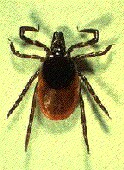
MONDAY, April 5 (HealthDay News) — In an effort to combat Lyme disease, researchers have found that tick-borne transmission might be preventable by deactivating a key gene in the bacteria that enables infection.
Though to date the strategy has been tested solely in mice, theoretically the discovery could lead toward development of a vaccine that reduces the risk for infection.
“Certain genes are activated by the bacteria that causes Lyme disease during tick feeding, and for the first time we found the one that is absolutely necessary to transmit infection,” said the study’s lead author, Robert D. Gilmore Jr., a research microbiologist and head of the molecular and cellular microbiology lab in the bacterial diseases branch at the U.S. Centers for Disease Control and Prevention in Fort Collins, Colo.
Their findings are published in the April 5-9 online edition of the Proceedings of the National Academy of Sciences.
Lyme disease is transmitted by the bite of a black-legged tick infected with the Borrelia burgdorferi bacteria, according to the CDC. If caught early, the agency notes, a regimen of antibiotics can successfully tackle the disease in most cases. But if symptoms — which include fever, headache, chills, a rash, muscle and joint aches and fatigue — are not swiftly diagnosed and treatment started, Lyme disease can move across a person’s joints, heart and nervous system.
In some instances, the ensuing infectious spread can provoke a host of problems, including severe joint pain and swelling, stiffness, heart palpitations, dizziness and a broad range of neurological issues. The exact mechanism underlying such long-term complications remains unclear, but some research has suggested that they might be the result of a compromised autoimmune response.
To cut Lyme disease off at the pass, Gilmore and his team set out to disrupt transmission at the genetic level. They homed in on the bacteria’s “bba64” gene, which had been identified in earlier research, and genetically altered the bacteria to disable the gene. After injecting the reengineered bacteria into test mice, they allowed black-legged ticks to feed on the inoculated rodents.
In turn, a separate batch of 15 healthy mice was exposed to the ticks, which were newly infected with the altered bacterial strain.
After exposure to the altered bacteria-carrying ticks for about two months, just two of the mice had acquired Lyme disease, the study authors found.
The researchers then extracted the altered bacteria from the same ticks and injected it directly into healthy mice. They found that when injected with the altered bacteria — rather than having been bitten by ticks that carried it — healthy mice did, in fact, acquire Lyme disease.
This led the scientists to conclude that the altered bacteria could still prompt Lyme disease, but, as a practical matter, the disease could not be transmitted via normal tick bites when the bba64 gene was rendered nonfunctional.
“Now that we’ve targeted something that seems to be important in transmission, the logical thing would be to go ahead and see if it would work as a vaccine candidate,” Gilmore explained.
“But I want to be clear that we have not yet done that,” he cautioned. “And when you find genes that could be targeted for intervention strategies, it doesn’t mean that it’s going to work. It’s an idea that now we have to test out.”
Dr. Raphael B. Stricker, an attending physician at the California Pacific Medical Center in San Francisco and past president of the International Lyme and Associated Diseases Society, described the current effort as a “really sophisticated approach” to combating Lyme disease.
“The notion that you can specifically block infection by blocking or knocking out this gene is very interesting from a basic science point of view,” Stricker said. “But I don’t really know how this is going to translate into a vaccine, which is the point of this study. And I would be concerned about the safety of this kind of vaccine,” he noted.
“But it’s absolutely worth further investigation,” he added. “And I would say that, if it would be safe, I think it would be very productive.”
More information
The U.S. Centers for Disease Control and Prevention has more on Lyme disease.

